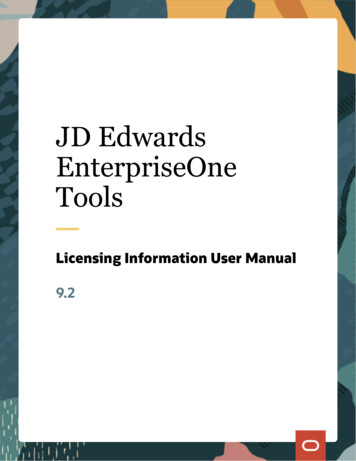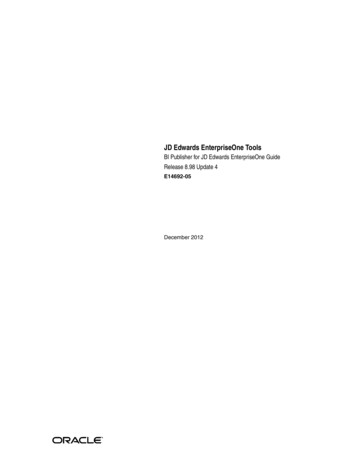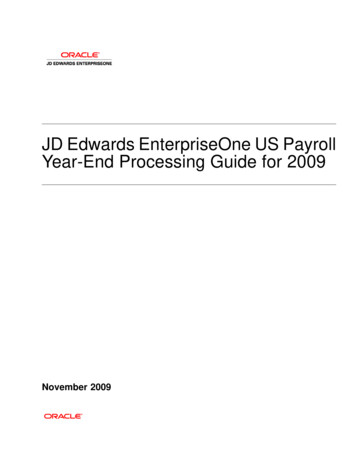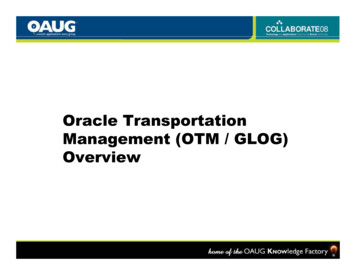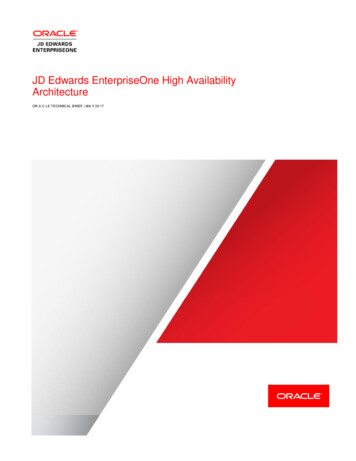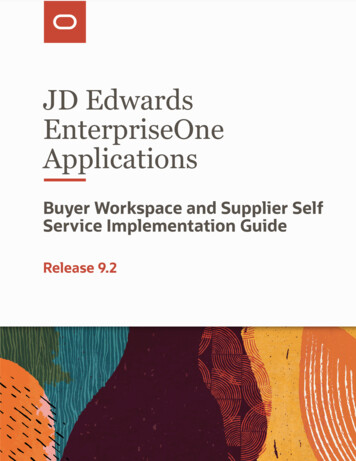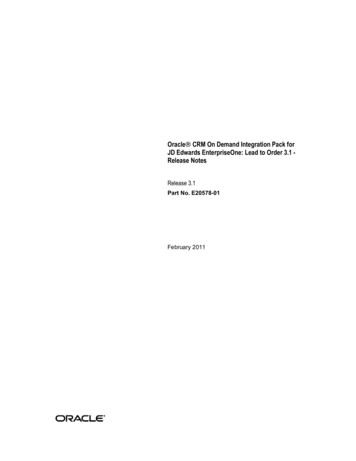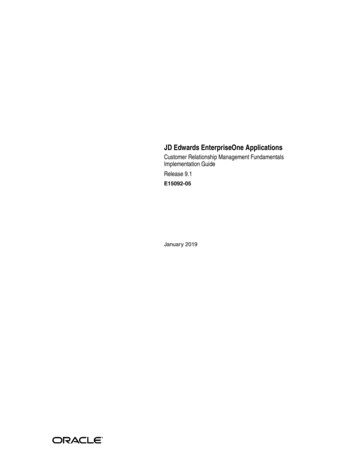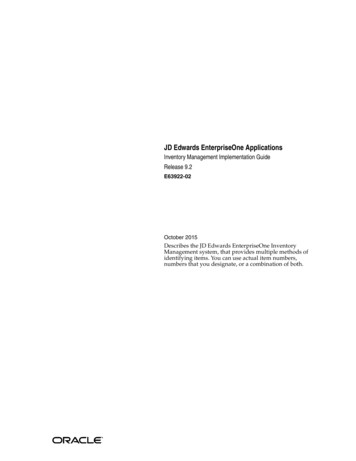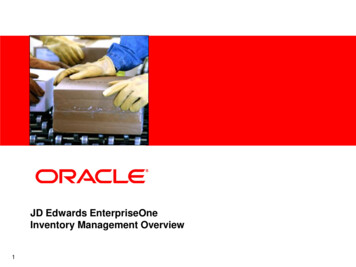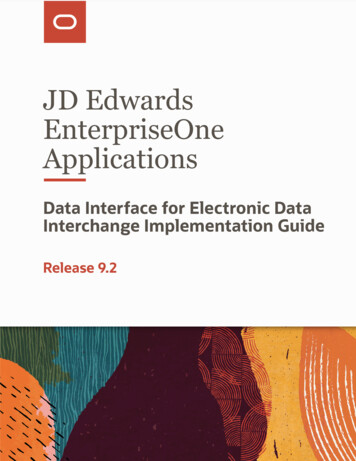
Transcription
JD EdwardsEnterpriseOneApplicationsData Interface for Electronic DataInterchange Implementation GuideRelease 9.2
JD Edwards EnterpriseOne ApplicationsData Interface for Electronic Data Interchange Implementation GuideRelease 9.2Part Number:E63905-04Copyright 2011, 2020, Oracle and/or its affiliates.This software and related documentation are provided under a license agreement containing restrictions on use and disclosure and are protectedby intellectual property laws. Except as expressly permitted in your license agreement or allowed by law, you may not use, copy, reproduce, translate,broadcast, modify, license, transmit, distribute, exhibit, perform, publish, or display any part, in any form, or by any means. Reverse engineering,disassembly, or decompilation of this software, unless required by law for interoperability, is prohibited.The information contained herein is subject to change without notice and is not warranted to be error-free. If you find any errors, please reportthem to us in writing.If this is software or related documentation that is delivered to the U.S. Government or anyone licensing it on behalf of the U.S. Government, thenthe following notice is applicable:U.S. GOVERNMENT END USERS: Oracle programs (including any operating system, integrated software, any programs embedded, installed oractivated on delivered hardware, and modifications of such programs) and Oracle computer documentation or other Oracle data delivered to oraccessed by U.S. Government end users are "commercial computer software" or "commercial computer software documentation" pursuant to theapplicable Federal Acquisition Regulation and agency-specific supplemental regulations. As such, the use, reproduction, duplication, release, display,disclosure, modification, preparation of derivative works, and/or adaptation of i) Oracle programs (including any operating system, integratedsoftware, any programs embedded, installed or activated on delivered hardware, and modifications of such programs), ii) Oracle computerdocumentation and/or iii) other Oracle data, is subject to the rights and limitations specified in the license contained in the applicable contract. Theterms governing the U.S. Government's use of Oracle cloud services are defined by the applicable contract for such services. No other rights aregranted to the U.S. Government.This software or hardware is developed for general use in a variety of information management applications. It is not developed or intended foruse in any inherently dangerous applications, including applications that may create a risk of personal injury. If you use this software or hardwarein dangerous applications, then you shall be responsible to take all appropriate fail-safe, backup, redundancy, and other measures to ensure its safeuse. Oracle Corporation and its affiliates disclaim any liability for any damages caused by use of this software or hardware in dangerous applications.Oracle and Java are registered trademarks of Oracle and/or its affiliates. Other names may be trademarks of their respective owners.Intel and Intel Inside are trademarks or registered trademarks of Intel Corporation. All SPARC trademarks are used under license and are trademarksor registered trademarks of SPARC International, Inc. AMD, Epyc, and the AMD logo are trademarks or registered trademarks of Advanced MicroDevices. UNIX is a registered trademark of The Open Group.This software or hardware and documentation may provide access to or information about content, products, and services from third parties. OracleCorporation and its affiliates are not responsible for and expressly disclaim all warranties of any kind with respect to third-party content, products, andservices unless otherwise set forth in an applicable agreement between you and Oracle. Oracle Corporation and its affiliates will not be responsiblefor any loss, costs, or damages incurred due to your access to or use of third-party content, products, or services, except as set forth in an applicableagreement between you and Oracle.
JD Edwards EnterpriseOne ApplicationsData Interface for Electronic Data InterchangeImplementation GuideContentsPreface . i1Introduction to JD Edwards EnterpriseOne Data Interface for ElectronicData Interchange1JD Edwards EnterpriseOne Data Interface for Electronic Data Interchange Overview . 1JD Edwards EnterpriseOne Data Interface for Electronic Data Interchange System Integration . 2JD Edwards EnterpriseOne Data Interface for Electronic Data Interchange Implementation . 32Understanding Data Interface for the Electronic Data Interchange System7Understanding the Electronic Data Interchange System . 7Understanding EDI Standards . 8Understanding EDI Document Processing . 10Understanding Electronic Documents Supported by the JD Edwards EnterpriseOne System . 10Understanding Program and Table Naming Conventions . 123Setting Up Interfaces for Electronic Data Interchange15Understanding EDI Interfaces . 15Understanding Flat File Data Formatting . 17Setting Up Customer Billing Instructions . 23Establishing EDI Information for Suppliers . 27Defining EDI Tolerance Rules . 284Processing EDI Documents31. 31Receiving EDI Standard Business Documents . 31Sending EDI Standard Business Documents . 34Purging Data from the EDI Interface Tables . 375Running Inquiries and Revising EDI Documents41Understanding EDI Documents . 41
JD Edwards EnterpriseOne ApplicationsData Interface for Electronic Data InterchangeImplementation GuideDetermining Document Status . 41Revising EDI Documents . 42Reviewing or Changing Inbound Shipping Information . 43Reviewing or Changing Outbound Invoice Information . 446Receiving and Sending Electronic Data Interchange Sales OrderDocuments49Receiving Requests for Quotes (840/REQOTE) . 49Receiving Customer Orders (850/ORDERS) . 52Receiving Customer Order Changes (860/ORDCHG) . 58Receiving Advice into Sales (861/RECADV) . 61Receiving Ship and Debit Claim Acknowledgments (845/PRICAT) . 64Receiving Ship and Debit Claim Status (849/ORDRSP) . 66Sending Responses to Requests for Quotes (843/QUOTES) . 68Sending Order Acknowledgments (855/ORDRSP) . 70Sending Order Change Acknowledgments (865/ORDRSP) . 71Sending Shipping Notices (856/DESADV) . 73Sending Invoices (810/INVOIC) . 79Sending Ship and Debit Claims (844/ORDCHG) . 827Receiving and Sending Electronic Data Interchange Demand SchedulingExecutions Documents83Demand Scheduling Execution EDI Transactions and Messages . 838Processing EDI Purchase Order Documents93Understanding EDI Purchase Order Document Processing . 93Receiving PO Change Acknowledgments . 93Receiving Advice Documents into Purchasing . 96Receiving Invoices with Receipt Matches . 100Receiving PO Acknowledgments . 103Receiving Shipping Notices . 105Sending Requests for Quotes . 107Sending Purchase Orders . 108Sending Purchase Order Changes . 109Sending Receiving Advice . 110Sending Shipping Schedules . 111
JD Edwards EnterpriseOne ApplicationsData Interface for Electronic Data InterchangeImplementation Guide9Processing EDI Inventory Documents115Understanding EDI Inventory Document Processing . 115Receiving Product Activity Data . 115Sending Product Activity Data . 11810Processing EDI Scheduling and Planning Documents121Understanding EDI Scheduling and Planning Document Processing . 121Receiving Planning Schedule Forecasts . 121Sending Planning Schedule Forecasts . 12311Using EDI Financial Documents125Understanding Financial Documents . 125Understanding the Creation of Inbound EDI Vouchers . 125Receiving Invoice-Summary Documents (810/INVOIC) . 126Processing Voucher Information . 127Receiving Lockbox Transactions (823/CREMUL) . 129Sending Payment Orders with Remittance (820/PAYEXT) . 13512Appendix A - JD Edwards EnterpriseOne Solution IDs for EDI Transactions 139Electronic Data Interchange Solution IDs . 139
JD Edwards EnterpriseOne ApplicationsData Interface for Electronic Data InterchangeImplementation Guide
JD Edwards EnterpriseOne ApplicationsData Interface for Electronic Data InterchangeImplementation GuidePrefacePrefaceWelcome to the JD Edwards EnterpriseOne Applications Data Interface for Electronic Data Interchange ImplementationGuide.AudienceThis guide is intended for implementers and end users of the JD Edwards EnterpriseOne Data Interface for ElectronicData Interchange system.JD Edwards EnterpriseOne ProductsThis implementation guides refers to these JD Edwards EnterpriseOne products from Oracle: JD Edwards EnterpriseOne Accounts Payable JD Edwards EnterpriseOne Accounts Receivable JD Edwards EnterpriseOne Demand Scheduling Execution JD Edwards EnterpriseOne Inventory Management JD Edwards EnterpriseOne Procurement JD Edwards EnterpriseOne Sales Order ManagementNote: This implementation guide documents only form elements that require additional explanation. If a formelement is not documented with the process or task in which it is used, then it either requires no additionalexplanation or is documented with the common fields for the section, chapter, or implementation guide.JD Edwards EnterpriseOne Application FundamentalsThe JD Edwards EnterpriseOne Data Interface for Electronic Data Interchange Implementation Guide provides youwith implementation and processing information for the JD Edwards EnterpriseOne EDI solution. However, additional,essential information describing the setup and design of the system resides in companion documentation. Thecompanion documentation consists of important topics that apply to many or all JD Edwards EnterpriseOne productslines. The companion volume for Data Interface for Electronic Data Interchange is:JD Edwards EnterpriseOne Financial Management Application Fundamentals Implementation Guide.Customers must conform to the supported platforms for the release as detailed in the JD Edwards EnterpriseOneminimum technical requirements. In addition, JD Edwards EnterpriseOne may integrate, interface, or work with otherOracle products. Refer to the cross-reference material in the Program Documentation at http://oracle.com/contracts/index.html for Program prerequisites and version cross-reference documents to assure compatibility of various Oracleproducts.Note: JD Edwards EnterpriseOne Applications Financial Management Fundamentals Implementation Guide .i
JD Edwards EnterpriseOne ApplicationsData Interface for Electronic Data InterchangeImplementation GuidePrefaceDocumentation AccessibilityFor information about Oracle's commitment to accessibility, visit the Oracle Accessibility Program website atwww.oracle.com/pls/topic/lookup?ctx acc&id docacc .http://Access to Oracle SupportOracle customers that have purchased support have access to electronic support through My Oracle Support. Forinformation, visit http://www.oracle.com/pls/topic/lookup?ctx acc&id info or visit http://www.oracle.com/pls/topic/lookup?ctx acc&id trs if you are hearing impaired.Related InformationFor additional information about JD Edwards EnterpriseOne applications, features, content, and training, visit the JDEdwards EnterpriseOne pages on the JD Edwards Resource Library located at:http://learnjde.comConventions and Screen ImagesThe following text conventions are used in this document:ConventionMeaningboldfaceBoldface type indicates graphical user interface elements associated with an action, or terms defined intext or the glossary.ItalicsItalic type indicates book titles, emphasis, or placeholder variables for which you supply particularvalues.MonospaceMonospace type indicates commands within a paragraph. URLs, code in examples, text that appearson the screen, or text that you enter.ii
JD Edwards EnterpriseOne ApplicationsData Interface for Electronic Data InterchangeImplementation GuideChapter 1Introduction to JD Edwards EnterpriseOne Data Interfacefor Electronic Data Interchange1Introduction to JD Edwards EnterpriseOneData Interface for Electronic Data InterchangeJD Edwards EnterpriseOne Data Interface for ElectronicData Interchange OverviewElectronic Data Interchange (EDI) is the paperless, computer to computer exchange of business transactions, suchas purchase orders and invoices, in a standard format with standard content. As such, it is an important part of anelectronic commerce strategy.Electronic commerce is a means to extend business processes to include suppliers, customers, and employees in a fullyintegrated supply chain. It can yield shorter cycle times, more efficient inventory management, and better knowledgesharing throughout the extended enterprise. To see these benefits, you need an integrated enterprise applicationsystem that you can extend and customize for the supply chain, while still maintaining enterprise information integrity.The JD Edwards EnterpriseOne Data Interface for Electronic Data Interchange system from Oracle includes features forenterprise resource planning that enable you to use electronic commerce for these business interactions: Business to business: Planning, processing, and tracking information across the supply chain. Business to consumer: Connecting the company with the customers. Business to employee: Exchanging information and automating key business processes.EDI is a crucial part of business to business commerce. When computers exchange data using EDI, the data istransmitted in EDI Standard format so that it is recognizable by other systems using the same EDI Standard format.Companies who use EDI have their own translator software package to convert the data from the EDI Standard format totheir computer system's format. Companies that exchange EDI data are called trading partners.As an interface between the JD Edwards EnterpriseOne system data and the translator software, the JD EdwardsEnterpriseOne Data Interface for Electronic Data Interchange system (code 47) acts as a staging area for moving datain and out of the application systems. In addition to exchanging EDI data, you can use this data interface for generalinteroperability and electronic commerce needs where a file based interface meets the business requirements.Some benefits of using the JD Edwards EnterpriseOne Data Interface for Electronic Data Interchange system are: Shorter fulfillment cycle. Reduced errors. Increased information integrity through reduced manual data entry. Reduced clerical work for the manual manipulation of documentation. Increased competitiveness in the marketplace. Improved delivery of goods and services. Decreased time in generating payments and invoices. Decreased time in recording receipts of payment.1
JD Edwards EnterpriseOne ApplicationsData Interface for Electronic Data InterchangeImplementation GuideChapter 1Introduction to JD Edwards EnterpriseOne Data Interfacefor Electronic Data InterchangeJD Edwards EnterpriseOne Data Interface for ElectronicData Interchange System IntegrationThe JD Edwards EnterpriseOne Data Interface for Electronic Data Interchange system integrates with these JDEdwards EnterpriseOne systems from Oracle: Sales Order Management Procurement Inventory Management Accounts Payable Accounts Receivable Demand Scheduling ExecutionWe discuss integration considerations in the implementation chapters in this implementation guide. Supplementalinformation about third-party application integrations is located on the Oracle Support website.JD Edwards EnterpriseOne Sales Order ManagementYou can enhance customer service by using the JD Edwards EnterpriseOne Sales Order Management system to createorder templates and standing or blanket orders. This system also provides additional customer service support throughonline displays that give: Pertinent order, inventory, transportation, and financial information. Net profitability of a product line when promotions, discounts, and allowances are applied.JD Edwards EnterpriseOne ProcurementThe JD Edwards EnterpriseOne Procurement system accommodates a diverse range of purchasing activities for: Replenishing inventory. Acquiring materials used to complete projects. Charging purchased goods and services to specific departments, jobs, or cost centers.Procurement involves order entry through actual payment for the goods and services that you receive.JD Edwards EnterpriseOne Inventory ManagementThe JD Edwards EnterpriseOne Inventory Management system defines discreet inventory items, which enables youto manipulate inventory throughout the supply chain. Item identification and processing characteristics are the basicinformation elements that are specific to individual items across an entire company. This information can be furtherdefined by facility to provide geographic or market flexibility.2
JD Edwards EnterpriseOne ApplicationsData Interface for Electronic Data InterchangeImplementation GuideChapter 1Introduction to JD Edwards EnterpriseOne Data Interfacefor Electronic Data InterchangeJD Edwards EnterpriseOne Accounts PayableThe JD Edwards EnterpriseOne Accounts Payable system enables you to manage supplier relationships and processinvoices and payments.JD Edwards EnterpriseOne Accounts ReceivableThe JD Edwards EnterpriseOne Accounts Receivable system helps you to manage cash flow with the flexibility thatyou need for effective cash management. You can streamline the day to day functions of the entire accounts receivabledepartment. You can simplify and accelerate the process of applying receipts.JD Edwards EnterpriseOne Demand Scheduling ExecutionYou use the JD Edwards EnterpriseOne Demand Scheduling Execution system to manage requirements for shipmentand production schedules between customers and suppliers. Firm or planned demand requirements enable you toreceive, interpret, validate, or forecast net order information for shipments, and to automatically communicate shipmentdetails to the supplier or customer. The system interprets and receives information using Electronic Data Interchange(EDI) documents that are transmitted from customers to suppliers, and then populates the appropriate DemandScheduling Execution tables to create records, sales orders, and forecasts. You set up the Demand Scheduling Executionsystem to manage all of this information.JD Edwards EnterpriseOne Data Interface for ElectronicData Interchange ImplementationThis section provides an overview of the steps that are required to implement the JD Edwards EnterpriseOne DataInterface for Electronic Data Interchange system.In the planning phase of the implementation, take advantage of all JD Edwards EnterpriseOne sources of information,including the installation guides and troubleshooting information.When determining which electronic software updates (ESUs) to install for JD Edwards EnterpriseOne Data Interfacefor Electronic Data Interchange, use the EnterpriseOne and World Change Assistant. EnterpriseOne and World ChangeAssistant, a Java-based tool, reduces the time required to search and download ESUs by 75 percent or more andenables you to install multiple ESUs simultaneously.See JD Edwards EnterpriseOne Tools Software Updates Guide .Global Implementation StepsThe implementation steps for JD Edwards EnterpriseOne Data Interface for Electronic Data Interchange:1. Set up global user-defined codes.3
JD Edwards EnterpriseOne ApplicationsChapter 1Data Interface for Electronic Data InterchangeIntroduction to JD Edwards EnterpriseOne Data InterfaceImplementation Guidefor Electronic Data InterchangeSee "Working with User Defined Codes" in the JD Edwards EnterpriseOne Tools System Administration Guide .2. Set up companies, fiscal date patterns, and business units.See "Setting Up Organizations" in the JD Edwards EnterpriseOne Applications Financial ManagementFundamentals Implementation Guide .3. Set up next numbers.See "Setting Up Next Numbers" in the JD Edwards EnterpriseOne Applications Financial ManagementFundamentals Implementation Guide .4. Set up accounts and the chart of accounts.See "Creating the Chart of Accounts" in the JD Edwards EnterpriseOne Applications Financial ManagementFundamentals Implementation Guide .5. Set up General Accounting constants.See "Setting Up Constants for General Accounting" in the JD Edwards EnterpriseOne Applications GeneralAccounting Implementation Guide .6. Set up multicurrency processing, including currency codes and exchange rates.See "Setting Up General Accounting for Multicurrency Processing" in the JD Edwards EnterpriseOneApplications Multicurrency Processing Implementation Guide .See "Setting Up Exchange Rates" in the JD Edwards EnterpriseOne Applications Multicurrency ProcessingImplementation Guide .7. Set up ledger type rules.See "Setting Up Ledger Type Rules for General Accounting" in the JD Edwards EnterpriseOne ApplicationsGeneral Accounting Implementation Guide .8. Enter address book records. If required, you can also enter global location numbers (GLN) for customers,suppliers, carriers, internal business units, and so on.See "Entering Address Book Records" in the JD Edwards EnterpriseOne Applications Address BookImplementation Guide .9. Set up inventory information, such as branch/plant constants, default locations and printers, manufacturingand distribution AAIs, and document types.See "Setting Up the Inventory Management System" in the JD Edwards EnterpriseOne Applications InventoryManagement Implementation Guide .10. Set up shop floor calendars.See "Setting Up Shop Floor Management" in the JD Edwards EnterpriseOne Applications Shop FloorManagement Implementation Guide .11. Set up manufacturing constants.See "Setting Up Manufacturing Constants" in the JD Edwards EnterpriseOne Applications Product DataManagement Implementation Guide .4
JD Edwards EnterpriseOne ApplicationsData Interface for Electronic Data InterchangeImplementation GuideChapter 1Introduction to JD Edwards EnterpriseOne Data Interfacefor Electronic Data InterchangeData Interface for Electronic Data Interchange ImplementationStepsThe implementation steps for the JD Edwards EnterpriseOne Data Interface for Electronic Data Interchange system:1. Set up customer billing instructions.See Setting Up Customer Billing Instructions.2. Set up EDI information for a supplier.See Entering EDI Information for Suppliers.3. Set up item cross references.See "Maintaining Cross-References" in the JD Edwards EnterpriseOne Applications Demand SchedulingExecution Implementation Guide .4. Set up EDI tolerance rules.See Defining EDI Tolerance Rules.5. Format flat file data.See Flat File Data.6. Verify the report output destination in the .ini file. The .ini file contains a UBE section, UBEDBOutputLocation(the ID for the system value is 79), which the system retrieves if a user specifies an invalid output destination forthe EDI text files that the system generated. If you do not specify an .ini setting, the current working directory isthe default destination for the output.See JD Edwards EnterpriseOne Tools System Administration Guide5
JD Edwards EnterpriseOne ApplicationsData I
EDI is a crucial part of business to business commerce. When computers exchange data using EDI, the data is transmitted in EDI Standard format so that it is recognizable by other systems using the same EDI Standard format. Companies who use EDI have their own translator software package to convert the data from the EDI Standard format to
